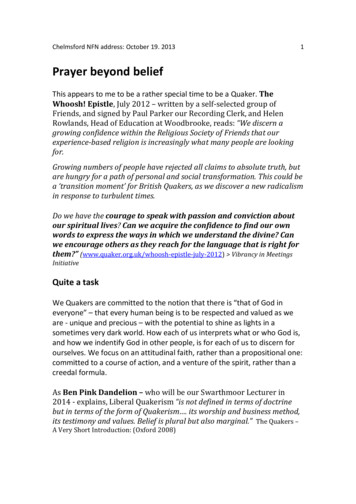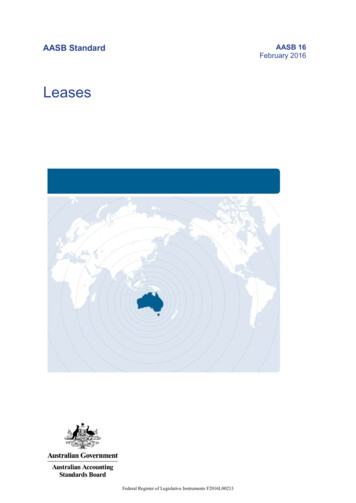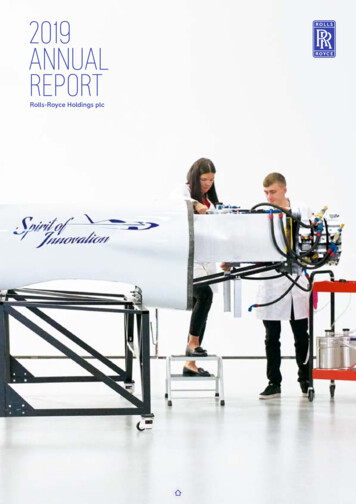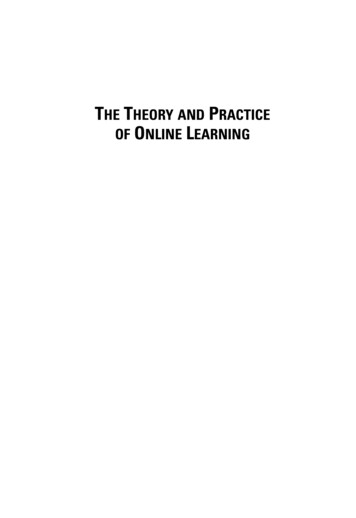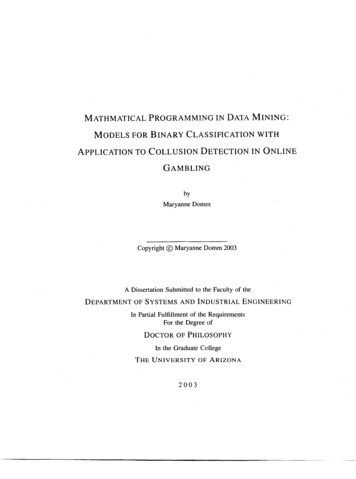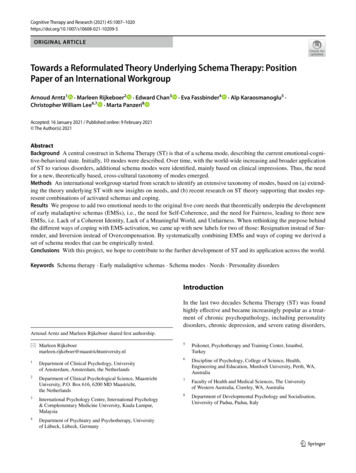
Transcription
Cognitive Therapy and Research (2021) 0209-5ORIGINAL ARTICLETowards a Reformulated Theory Underlying Schema Therapy: PositionPaper of an International WorkgroupArnoud Arntz1 · Marleen Rijkeboer2 · Edward Chan3Christopher William Lee6,7 · Marta Panzeri8· Eva Fassbinder4· Alp Karaosmanoglu5 ·Accepted: 16 January 2021 / Published online: 9 February 2021 The Author(s) 2021AbstractBackground A central construct in Schema Therapy (ST) is that of a schema mode, describing the current emotional-cognitive-behavioral state. Initially, 10 modes were described. Over time, with the world-wide increasing and broader applicationof ST to various disorders, additional schema modes were identified, mainly based on clinical impressions. Thus, the needfor a new, theoretically based, cross-cultural taxonomy of modes emerged.Methods An international workgroup started from scratch to identify an extensive taxonomy of modes, based on (a) extending the theory underlying ST with new insights on needs, and (b) recent research on ST theory supporting that modes represent combinations of activated schemas and coping.Results We propose to add two emotional needs to the original five core needs that theoretically underpin the developmentof early maladaptive schemas (EMSs), i.e., the need for Self-Coherence, and the need for Fairness, leading to three newEMSs, i.e. Lack of a Coherent Identity, Lack of a Meaningful World, and Unfairness. When rethinking the purpose behindthe different ways of coping with EMS-activation, we came up with new labels for two of those: Resignation instead of Surrender, and Inversion instead of Overcompensation. By systematically combining EMSs and ways of coping we derived aset of schema modes that can be empirically tested.Conclusions With this project, we hope to contribute to the further development of ST and its application across the world.Keywords Schema therapy · Early maladaptive schemas · Schema modes · Needs · Personality disordersIntroductionArnoud Arntz and Marleen Rijkeboer shared first authorship.* Marleen 1Department of Clinical Psychology, Universityof Amsterdam, Amsterdam, the Netherlands2Department of Clinical Psychological Science, MaastrichtUniversity, P.O. Box 616, 6200 MD Maastricht,the Netherlands3International Psychology Centre, International Psychology& Complementary Medicine University, Kuala Lumpur,Malaysia4Department of Psychiatry and Psychotherapy, Universityof Lübeck, Lübeck, GermanyIn the last two decades Schema Therapy (ST) was foundhighly effective and became increasingly popular as a treatment of chronic psychopathology, including personalitydisorders, chronic depression, and severe eating disorders,5Psikonet, Psychotherapy and Training Center, Istanbul,Turkey6Discipline of Psychology, College of Science, Health,Engineering and Education, Murdoch University, Perth, WA,Australia7Faculty of Health and Medical Sciences, The Universityof Western Australia, Crawley, WA, Australia8Department of Developmental Psychology and Socialisation,University of Padua, Padua, Italy13Vol.:(0123456789)
1008and it was disseminated rapidly in many cultures all overthe world (Arntz and Jacob 2012; Arntz and van Genderen2009; Chan and Tan 2020; Jacob and Arntz 2013; Rafaeliet al. 2010; Renner et al. 2013; Sempérteguia et al. 2013;Simpson et al. 2010; Young et al. 2003). ST was formulatedin the late former century by Jeffrey Young as an extensionof cognitive-behavioral therapy (CBT), integrating elementsfrom different schools (e.g., experiential and psychodynamictherapies), the attachment literature, and other developmental theories into a coherent theory (Young 1994; Young et al.2003). Since then ST has evolved considerably, includinge.g., the advancement of the mode construct, and the development of specific modes for borderline personality disorder(Lobbestael et al. 2007, 2008, 2010; Young et al. 2007),cluster C personality disorders (Bamelis et al. 2011), andforensic psychopathology (Keulen de Vos et al. 2016,2017).However, a clear theoretical framework that steers the addition of these concepts is lacking. Moreover, although ST isused worldwide, it remains unclear whether these conceptsare equally valid across cultures (cf., Hofmann 2006). Forexample, ST was developed in the Western culture wherepeople tend to have more independent self-construals,whereas non-Western people have interdependent self-construals (Ayyash-Abdo et al. 2016). Hence, an internationalworkgroup, consisting of the authors of this paper who arefrom various cultural backgrounds, reviewed the fundamentsof the theory underlying ST, leading to a reformulation ofthis theory. The workgroup’s endeavors are laid down in thepresent position paper.Theory Underlying ST as OriginallyFormulated by Young and ColleaguesOrigin of Early Maladaptive SchemasAt first, the focus of ST was mostly on early maladaptiveschemas (EMSs), i.e., dysfunctional mental representationsthat are hypothesized to be formed during early development as the result of an interaction between temperamental factors in the child and adverse environmental factors,such as abuse, neglect, or dysfunctional parenting. In short,in ST, chronic (or characterological) psychopathology isthought to result when universal emotional needs are notadequately fulfilled during childhood. Young et al. (2003)hypothesized five emotional needs to be essential for healthydevelopment, i.e., (1) safety & nurturance (including safeattachment); (2) autonomy, competence, & sense of identity; (3) freedom to express needs, opinions, & emotions; (4)spontaneity & play, and (5) realistic limits & self-control.When these needs are not met, there is an increased risk thatthe child forms maladaptive schemas about the self, others,and the world, that interfere with healthy adaptation later in13Cognitive Therapy and Research (2021) 45:1007–1020life. Eighteen schemas have been formulated and groupedinto five domains, which correspond to the aforementionedhypothesized needs (see Table 1).The theory further states that specific stimuli can activateEMSs, and when fully activated these will dominate the feeling and information processing of the person. Behavioralresponses are not hypothesized to be part of the EMSs, butrather follow EMS activation.Coping with EMS ActivationPeople are thought to develop ways to deal with actualor impending/potential EMS activation. Young describedthree ways of coping with EMS activation: (1) surrender(giving in to the EMS activation, accepting the EMS asif it is true); (2) avoidance (avoiding or escaping EMSactivation by mental or behavioral responses); (3) overcompensation (the person fights the EMS by believing theopposite of the EMS is true, and feels and behaves accordingly). Note, that “coping” here denotes how the persondeals with an internal (mental) experience, the (threat of)activation of an EMS, and is not about how the persondeals with external circumstances. Moreover, accordingTable 1 Overview of needs (original and additional) and the respective Early Maladaptive Schemas (EMSs)NeedsOriginalSafety & nurturanceRespective EMSsOriginalEmotional deprivationMistrust/abuseAbandonmentSocial isolationDefectiveness/shameAutonomy, competence, & identity Dependence/incompetenceFailureVulnerability to harm & illnessEnmeshmentFreedom to express needs, opinions, Subjugation& emotionsSelf-sacrificeApproval seekingSpontaneity & playNegativity/pessimismEmotional inhibitionUnrelenting standardsPunitivenessRealistic limits & self-controlEntitlement/grandiosityInsufficient f-coherenceLack of a coherent identityLack of a meaningful worldFairnessUnfairness
Cognitive Therapy and Research (2021) 45:1007–1020to the original theory coping responses are generally automatic and people are not necessarily making a consciousdecision for them.Schema ModesCoping responses to EMSs result in so-called schemamodes, which describe the momentary emotional-cognitive-behavioral state of the person, whereas EMSs aremore trait like. Furthermore, in contrast to EMSs, schemamodes include behavior and are more directly connectedto the problems (symptoms) of the patient.Young et al. (2003) proposed three types of dysfunctional modes. Firstly, they identified child modes, whichare strongly related to EMSs, and in which the personfeels, thinks, and behaves as a child. Secondly, internalized parent modes were distinguished, describing states inwhich the person experiences excessive self-punishmentor extreme demands for achievement or high standards.These are hypothesized to result from the internalizationof dysfunctional moral standards and related behavior ofcaregivers. Thirdly, there are coping modes, which denotethe state of being in which attempts to escape or compensate the EMS dominate. Examples are the DetachedProtector (feeling nothing as the result of detaching fromemotions and needs) and the Self-Aggrandizer (aggrandizing one’s importance to compensate for an EMS withopposite implications). Note, that all dysfunctional modesare a combination of an activated EMS and a way of coping; in the child modes the individual “acquiesces” to theEMS activation, hence intense feelings that are tied to aspecific EMS dominate, whereas in the “coping” modesthe individual tries to avoid or “invert” its contents, andthus behaviors and thoughts that aim to undo the paincaused by a specific EMS dominate. Lastly, Young alsoidentified two functional modes, the Happy Child and theHealthy Adult Mode.Note, that the same EMS can underlie different types ofproblems. Which of these problems is expressed depends onthe type of schema mode(s) that are typically activated in theperson. For instance, the same EMS from the disconnectiondomain (e.g., Abandonment) can underlie both internalizing(e.g., abandonment depression) and externalizing forms ofpsychopathology (e.g., aggressively threatening the otherwho is abandoning the person), depending on the way ofcoping (see Wijk-Herbrink et al. 2018a, b, for an empiricaltest). Likewise, the same problem or symptom can resultfrom different EMSs, i.e., a symptom might be determinedby “surrender” to one schema, or by “overcompensation” foranother schema. For example, perfectionism as a symptomcan be the result of surrendering to a schema of UnrelentingStandards and/or overcompensation for a Failure schema.1009Developments in Schema TherapyModern approaches to ST are based on the schema modemodel. Schema modes are central to the application of STespecially with more severe patients, as they help clarify thestate the person is in, as well as the (often sudden) switchespatients make between such states. Moreover, current STprotocols describe specific techniques to be applied for specific modes. Research has corroborated that both patientsand therapists acknowledge the usefulness of the schemamode model in the treatment process, helping to form a(meta-cognitive) model of the patient’s problems and steering the treatment process (de Klerk et al. 2017; Tan et al.2018).Given the usefulness of the schema mode model, there isa growing need amongst clinicians and researchers worldwide for a cross-cultural, comprehensive taxonomy ofmodes. To enable a formulation of such a taxonomy, thetheoretical foundations of schema therapy were criticallyevaluated by the workgroup, and described in this positionpaper. We start with a discussion of the core emotional needsin early life, that underlie the development of EMSs. Thereis an extant literature on fundamental human needs, synthesized in several reviews (e.g., Baumeister and Leary 1995;Deci and Ryan 2000; Pittman and Zeigler 2007). Dweck(2017) recently elaborated on existing research, and developed a modern comprehensive theory of emotional needs,integrating motivation, personality, and (social-cultural)psychological development, hence unifying aspects ofearlier frameworks of needs. Dweck’s theory aligns withYoung’s ideas of personality development, but it is far moreelaborated and scientifically grounded. Therefore, we choseto start with Dweck’s framework as a reference point forevaluating the theoretical fundaments of schema therapy.Next, we discuss a fundamental need that might have beenoverlooked both in ST theory and in Dweck’s framework.Then we discuss the nature of coping in Young’s model andthe confusion surrounding these concepts, followed by thetheoretical guidelines for constructing a comprehensive setof modes. Lastly, we propose a set of schema modes basedon this renewed formulation of ST theory, and discuss howthe new formulation can be empirically tested.Evaluation and Reformulation of Young’sTheory of NeedsYoung’s and Dweck’s Needs Theories ComparedAs said, Young described five core emotional needs, whileacknowledging that these were not based on a comprehensive theory and that the set of needs he proposed might beincomplete (Young et al. 2003). Similar to Young et al.13
1010Cognitive Therapy and Research (2021) 45:1007–1020(2003), Dweck’s theory (2017) described how core emotional needs are important in the development of personality,using similar constructs as schemas (i.e., mental representations, called BEATs, which stands for beliefs, emotions, andaction tendencies) and schema modes (called online acts andexperiences). Dweck postulated seven evidence-based emotional needs (Fig. 1), and discussed empirical evidence foreach of them. In short, she argued that three emotional needsare most basic in development: acceptance, predictability,and competence. The need for acceptance represents theneed for positive social engagement, and overlaps with similar constructs proposed in the literature, such as connectedness, attachment, affiliation, belonging, or love (Dweck2017; see p. 691). This need is proposed to be present veryearly in development. The second primary need, i.e., theneed for (optimal) predictability, stands for “the desire toknow the relationships among events and among things inthe world: what follows what, what belongs with what, orwhat causes what” (Dweck 2017, p. 692). The third primaryneed according to Dweck is the need for competence, whichis the need to build “skills for acting in or on the world”(Dweck 2017, p. 692). Resting on empirical foundations,Dweck argued that the aforementioned needs are the earliestdevelopmentally and therefore are the most basic, i.e., theyappear starting in infancy, guide both goal-directed behavior and information processing even at that early stage, andwhen thwarted lead to serious risk and a failure to thrive.She goes on to argue that based on these three most basicneeds four ‘compound needs’ develop: the needs for trust,control, self-esteem/status, and self-coherence. Each of thefirst three evolve from the combination of a pair of basicneeds. In particular, the need for trust starts to evolve from7 to 9 months out of the combined needs for acceptance andpredictability. According to Dweck, these two basic needsare distinct until that age, and do not join into what we wouldcall trust. Similarly, the need for control evolves from thecombined needs for competence and predictability, and corresponds to what others called the need for agency, autonomy, and self-control. It represents the need to manipulatethe world, for which predictability of the world and competence in the necessary skills are a prerequisite. Finally, theneed for self-esteem/status gradually unfolds in the secondyear of development out of a conjunction of the needs foracceptance and competence. According to Dweck (2017, p.294), “the outcomes of both acceptance-related goals andcompetence-related goals provide information about one’smerits and standing”. The reason why these compound needsevolve later in time than the three basic needs is related tothe necessary cognitive and behavioral capacities that haveto develop first.The fourth and final compound need identified by Dweck,namely the need for self-coherence, stands for the desire tofeel psychologically intact and rooted. It is about the need forexperiencing the self as integrated and the world as meaningful, in relation to the person. These two sub-aspects arecalled identity and meaning. This need is fulfilled by thesuccessful integration of the areas of the six other needs.We tried to locate the five emotional needs described byYoung et al. (2003) within Dweck’s taxonomy, and constructed a map showing the relationship between the two(see Fig. 1). Below we present how each of the needs identified by Young maps onto Dweck’s system.Fig. 1 Young’s five emotional needs mapped onto Dweck’s sevenneeds. Left: Dweck’s seven needs: The three basic needs of acceptance, predictability, and competence; the compound or emergentneeds of trust, control, and self-esteem/status; and a seventh emergentneed of self-coherence at the intersection of all the other needs (freelyadapted from Dweck (2017)). Middle: Young’s five core emotionalneeds. Right: Young’s needs mapped onto Dweck’s needs. Note thatDweck’s superordinate need for self-coherence is not covered byYoung’s needs131. Safety & nurturance (including safe attachment). Thisneed covers the innate need of the child for support andacceptance by caregivers (e.g., to be calmed when in
Cognitive Therapy and Research (2021) 45:1007–10202.3.4.5.stress) and a predictable environment, in which trust forcaregivers and the environment develops. When support and acceptance are not met, the child may developthe EMSs “emotional deprivation”, “social isolation”,and/or “defectiveness/shame”; when no predictableenvironment is given, the EMSs “abandonment” and/or “mistrust/abuse” might develop. Therefore, this needoverlaps with the domain of Dweck’s needs of acceptance, predictability, and trust.Autonomy, competence & sense of identity. This needis about developing a sense of being able to make independent decisions, discovering the world, being able toovercome problems, and forming a sense of identity asan independent person with specific competencies. Thisoverlaps with the area in Dweck’s system where competence, control, and self-esteem/status lie.Freedom to express needs, opinions & emotions. In orderto be allowed to express needs, opinions, and emotions,the child has to expect that this will be accepted. Also,the child has to have a sense of competence that it is ableto verbalize these. Lastly, the child has to experience acertain status and self-esteem to feel socially allowed toexpress needs, opinions, and emotions—and conversely,expressing these will build up self-esteem and status.Hence, this need overlaps with the domain in Dweck’staxonomy defined by acceptance, competence, and selfesteem/status.Spontaneity & play. Both in humans and animals, playing is a way to develop competence. The need for spontaneity and play can therefore be placed in the area ofDweck’s need for competence.Realistic limits & self-control. Without realistic limits,the environment of the child becomes unpredictable anduncontrollable. Moreover, realistic limits offer learningexperiences in competence and control. This need cantherefore be placed in the area of predictability, competence, and control in Dweck’s taxonomy.As can be seen, Young’s list overlaps nicely with Dweck’staxonomy. However, Young’s overview of needs lacks theneed for self-coherence, which incorporates the two distinguishable aspects identity (“Who am I?”) and meaning(“How does/should the world work in ways that matter tome?”; Dweck 2017, p. 695). One could think that Young’sneed for autonomy, competence, and sense of identityincludes the need for self-coherence. However, the identity aspect of the former need relates more to experiencingidentity through achievement and competence (“I know alot about dinosaurs, I love climbing trees, I am good at soccer, etc.”) than experiencing self-coherence. Apart from theneed for self-coherence, Young’s list of emotional needs thusappears to cover the emotional needs of humans as definedby Dweck well. With the exception of self-coherence, we1011can therefore assume that the Early Maladaptive Schemas(EMSs) that are derived from these needs represent the fundamental maladaptive representations in humans well, andtherefore a systematic derivation of schema modes from thecombinations of EMSs and coping will lead to good coverage of the universe of modes.The Need for Self‑Coherence and Related EMSsBecause the need for self-coherence is missing in Young’staxonomy of needs, we propose that this need (with its twoaspects) and the related EMSs of lack of a coherent identity,and lack of a meaningful world should be added.Lack of a coherent identity refers to the representationof the self as non-coherent and diffuse, as consisting outof non-integrated parts, and in severe cases as consistingout of completely dissociated parts. Lack of a meaningfulworld refers to the representation of the world as meaningless, with the self being disconnected from the processestaking place in the world. Activation of these schemas willlead to feelings of confusion, estrangement, existential anxiety, the self and/or the world falling apart, being lost, et cetera. As experiences cannot be integrated into a meaningfulwhole, symptoms of dissociation and psychosis might result.Thus, we expect high levels of these EMSs in severe psychopathologies, for example in severe personality disorders(Borderline (identity diffusion), Schizoid, Schizotypal), Dissociative Identity Disorder, and severe (chronic) psychosis.For example, in Schizoid Personality Disorder, although onecan see one’s own life as meaningful and the self as integrated, there is an estrangement from the world around, asis presumably reflected by a high level of the EMS Lack of ameaningful world. Another example is Dissociative IdentityDisorder, which is characterized by the experience of theself as consisting of separated, fully dissociated parts, as ismost probably expressed by high levels of the EMS Lack ofa coherent identity. Still another example is Schizotypal Personality Disorder, where patients report extreme confusionabout their inner world, as well as their outer world, as weexpect is reflected by elevated scores on both EMSs withinthe domain of Self-Coherence. Therefore, these EMSs are awelcome addition to ST theory, as, in our view, they coverforms of psychopathology that were hitherto not encompassed by ST theory.The Need for FairnessDiscussion in the workgroup revealed that still anotherimportant need was missing in Young’s list: the need for fairness. Ethologists have discovered that monkeys, apes, dogs,and birds already have a need for fairness, for instance refusing food if they get clearly less (attractive) food than anotheranimal (e.g., Brosnan and de Waal 2014). This observation13
1012is incompatible with a simple rational economic view whereaccepting any food is better than refusing food and thereforegetting nothing. Hence, a need for fairness seems to play arole here. This need is assumed to promote cooperation withindividually known partners, also in humans (e.g., Starmanset al. 2017). Clinical observations indicate that frustratingthe need for fairness can lead to severe emotional problems,and empirical studies have documented associations betweenunfairness (inequality, injustice) and mental as well as physical health problems (e.g., Prilleltensky 2013), and demonstrated that the need for fairness is evident already early inchildhood (e.g., McAuliffe et al. 2017).One could argue that the need for fairness is just partof the need for trust, or predictability in Dweck’s model,and the need for safety in Young’s model. However, giventhe specificity of this need for species (including humans)that depend on individual cooperation, the specific triggers,and the specific primary response (protest, refusal, anger, cf.Brosnan and de Waal 2014), we felt that it would be useful topostulate it as a separate need. Note that the need for trust ismore related to predictable social affiliation than to cooperation. Also, note that fairness implies predictability, but predictability does not imply fairness: unfair treatment can behighly predictable. Hence, we propose a core need for fairness, which, when frustrated, can lead to the development ofan EMS of Unfairness—a fundamental representation of (a)the world (including but not necessarily restricted to otherpeople) as being unfair and unjust, (b) the society as lackingjustice, thus not correcting those that behave unfairly, and (c)the self as a (continuous) victim of unfairness.The last aspect is essential, as it represents the emotionalpain that is part of this EMS (see also Ellis and Ellis 2011).Activation of this schema will lead to feelings of indignation and anger combined with powerlessness. It might bedifficult for people with this EMS to deal with even slightexperiences of unfairness. It is expected that this EMS ischaracteristic for people who behave in a victimized wayand easily feel resentment because of (perceived) unequaltreatment between them and others.After having discussed basic needs and based on thatanalysis having added three EMSs to the 18 proposed byYoung et al. (2003), we will now discuss how differentways of dealing with activation of an EMS lead to differentschema modes.Evaluation and Reformulation of Copingwith EMS ActivationCoping as Formulated in the Original ST TheoryAs was delineated in the introduction, ST theory states thatthe way a person copes with the (threat of) activation of an13Cognitive Therapy and Research (2021) 45:1007–1020EMS leads to a state of feeling, thinking, and behaving thatis called a schema mode. Three ways of (dysfunctional) coping are described: surrender, avoidance, and overcompensation. We now describe them step by step.1. Surrendering to an EMS activation leads to a state offeeling, thinking, and behaving as if the EMS is true.Two main groups of schema modes can result. First, adysfunctional child mode can result from yielding to anEMS activation: the person feels as if (s)he is a childin a world defined by the representation of the EMS.For instance, an EMS of Abandonment can lead to theAbandoned Child mode when surrender is the way ofcoping. In this mode, the person feels the panic anddesolation that is normal and functional for a little childthat is abandoned, and which creates a strong drive torestore the connection with the caregiver. Second, if theEMS is based on the internalization of moral or achievement values, an internalized parent mode can result. Forinstance, surrendering to the EMS Punitiveness can leadto activation of the Punitive Parent Mode.2. Avoidance of (full) EMS activation leads to the avoidance strategy dominating the person’s state. Severalavoidant coping modes have been described, e.g. theDetached Protector (detaching from emotions, needs,and beliefs associated with the EMS, resulting in arobot-like state), and the Self-Soother (actively engagingin behavior that soothes the emotional pain associatedwith the EMS).3. Overcompensation of an EMS leads to a state in whichthe opposite of the EMS is felt and believed, while thebehavior serves to prove this opposite. Perhaps the bestknown example is that of the Self-Aggrandizer, whichovercompensates EMSs such as Failure and/or Emotional Deprivation.As far as we know, two studies have tested the modelproposing that the way of handling EMS activation mediatesthe relationship between EMSs and schema modes. Bothstudies used a newly developed Schema Coping Inventory(Rijkeboer et al. 2010), to assess the way of coping thatpeople tend to use when confronted with an EMS activation. In the first study, Rijkeboer and Lobbestael (2012)did formal mediation tests on a large data set consisting ofadult patient respondents (N 1602), splitting the sample intwo for cross-validation purposes. In short, clear evidencewas found for the mediating role of coping responses in therelationship between specific EMSs and schema modes foralmost every combination tested (explained variance rangedfrom 0.34 to 0.74).The second study was conducted on data of a mixedpatient and non-patient sample of 699 adolescents (vanWijk-Herbrink et al. 2018a, b). To reduce the number of
Cognitive Therapy and Research (2021) 45:1007–1020tests, only EMSs of the first domain of disconnection andrejection were investigated. The study found evidence forthe relationship between first domain EMSs and Vulnerable Child mode being mediated by surrender coping, therelationship between first domain EMSs and Detached Protector mode being mediated by avoidance coping, and therelationship between first domain EMSs and Angry Childmode being mediated by overcompensating coping.Thus, findings seem to corroborate the theory as originally formulated by Young et al. (2003).Yet, discussion in the workgroup revealed a problemwith both studies, that is, the Schema Coping Inventoryhad a subscale for overcompensation that by hindsightseems to assess externalization (thus a fight response),highlighting the confusion that exists around the definition of the ways of coping in ST theory. We will elaborateon this below.Coping with Internal Triggers Versus ExternalThreatsYoung derived the three ways of coping with EMS activation as psychological analogues of basic survival responsesin animals when faced with a severe threat (i.e., attack):fight (cf., overcompensation), flight (cf., avoidance), andfreeze (cf., surrender). However, there is a loose relationship between these innate defense responses against acuteexternal threats and the mental operations that people canemploy to deal with EMS activation, which is confusing.In schema theory, we need to describe how people handle EMS activation, which primarily has an intrapsychicfunction, and not a function to deal with external threats.Nevertheless, external circumstances can trigger an EMS,which through the way a person handles this a
Background A central construct in Schema Therapy (ST) is that of a schema mode, describing the current emotional-cogni-tive-behavioral state. Initially, 10 modes were described. Over time, with the world-wide increasing and broader application of ST to various disorders, additional schema modes were identied, mainly based on clinical impressions.
